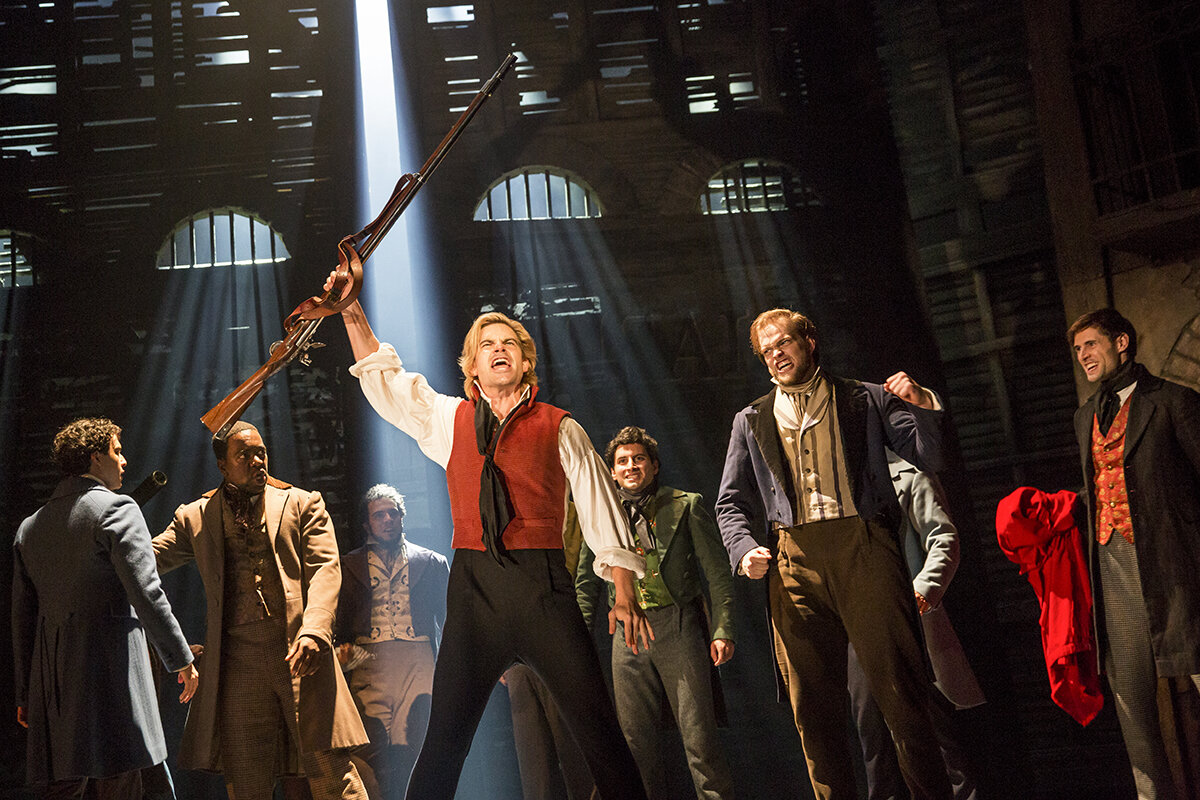Les Misérables
Music by Claude-Michel Schönberg
Lyrics by Alain Boublil & Jean-Marc Natel (French); Herbert Kretzmer (English)
Performance Date: May 7, 2019
Chuck and I outside the theater! Fun fact, this was actually my second time seeing the show here: I saw a tour of the original production here with my best friend Lacey in late 2004…nearly 15 years prior to this!
Born in late 1985, and exposed to musicals at a very early age, it’s perhaps no surprise that there’s a special place in my heart for the British mega-musicals of the 80’s and 90’s. Phantom, Miss Saigon, Cats, and this little gem, Les Misérables.
While not my favorite of the four, Les Mis definitely sits on a special pedestal. Not the least of which because I’ve had the privilege of appearing in it twice: in 1994 as Gavroche at Broadway Bound Little Theater in Temecula, and 19 years later as Grantaire/Ensemble in RCC’s 2003 Summer Conservatory. It’s a thrilling show to be a part of, and while I don’t think it quite makes my top five, it’s most definitely in my top ten.
Like my review for Cats, I’m going to focus primarily on the actual production we saw, not on the material itself (although, if that’s an interest to anyone, let me know, and I could look into it). This production is a tour of the 25th anniversary production, with completely new staging and design. Some of these new elements were great, and others...well, artistic interpretation counts for something, right?
A variety of sliding portals now help mask parts of the stage for faster scene changes, since the turntable no longer exists
Noticeable right for the beginning is the new scenic design. Gone is the iconic turntable and the addition of projections. Sadly, both times I’ve performed the show, we didn’t have a turntable, either, so I’m used to the show without one, but it’s still a great scenic element, and the original production used it to great effect. The projections were unobtrusive (except the moment that we travel under the street into sewers after barricade scenes); from what I’ve read, the paintings were all by Victor Hugo (who, you know, wrote the original book). I’m generally leery of projections-as-set, but they merely formed a backdrop, so my fears were assuaged.
Unlike the original production, the barricade also isn’t used as often, and it also doesn’t unfold as it did originally. It’s not a bad thing, but it was a cool image nonetheless, so I was little bummed that it wasn’t included. Instead, two scenic elements framing action right behind the proscenium (think like the opera boxes in Phantom, for those of you who know what I’m talking about) slide out, and can even meet in center stage, becoming a de facto backdrop masking upstage if needed. This provided a lot of vertical playing space as well, but I honestly missed the image of the bridge above the two sections of the barricade during “Look Down”.
Mary Kate Moore as Fantine
There were some interesting staging choices in the show. Since the release of the 2012 film version, I’ve been a big fan of flipping the order of “I Dreamed a Dream” and “Lovely Ladies”, but the stage version continues to use the original order (my thoughts on this can definitely be expanded on in a separate review). Our Fantine, Mary Kate Moore, was adequate, although her “I Dreamed a Dream” was a little too pretty for my taste (granted, Anne Hathaway’s version is really the only version of it I’ve ever liked (and no offense intended to the two separate Fantine’s I’ve performed alongside)). There was an AMAZING staging choice in “Lovely Ladies” when, as Fantine decides to become a prostitute, her first customer is the factory foreman who fired her in the first place, starting her on this path. It’s an amazing insult to injury, and I don’t know why no one else has ever thought about it.
Nick Cartell as Valjean
The rest of the cast was fine; Nick Cartell as Valjean seemed a little young, making the older Valjean seem a little unbelievable, but his “Bring Him Home” nearly earned a full standing ovation. Paige Smallwood as Éponine was also fantastic. Marius, as a role, has never seemed to be all that interesting to me, but Joshua Grosso gave Marius a silly, nervous quality during “A Heart Full of Love” that actually drew some laughs, which I’ve never heard before. Additionally, there was a bit of Thénardier’s material that was given to Madame Thénardier. It was unusual, but I was a fan, as she doesn’t have much to do in the show otherwise, when compared to the rest of the principles.
Finally, the 25th anniversary production debuts a new orchestration of the show, and it sounds amazing! Cleaner sounds, updated instruments, and richer notes made this production a joy to listen to. I don’t know much about music (to Chuck’s disappointment, I’m sure), but I was loving the music.
Overall, while I love the original production, the material itself helped me overcome my thoughts on this new staging. Given the choice between the two, I’d prefer to see the original, but reimaginings aren’t a bad thing (well, that new Phantom staging is a different story), and advancements in technology and just...giving something a new look can breathe new life into material that’s played continuously somewhere in the world for the last quarter-century. I do wish the original production in London wasn’t closing, so I could, at some point, see it, but I’ll take this reimagined and refreshed version over no version at all.
FINAL GRADE: B+






